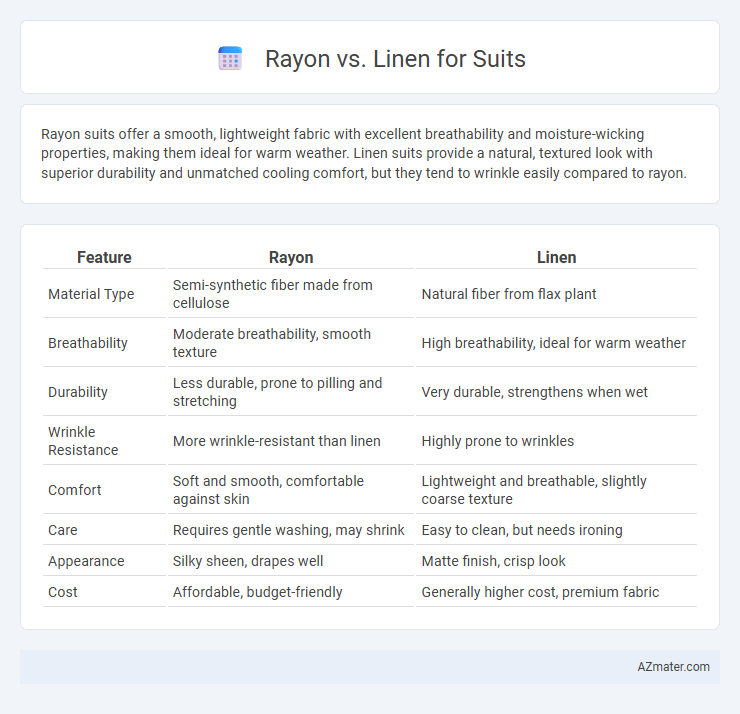Rayon suits offer a smooth, lightweight fabric with excellent breathability and moisture-wicking properties, making them ideal for warm weather. Linen suits provide a natural, textured look with superior durability and unmatched cooling comfort, but they tend to wrinkle easily compared to rayon.
Table of Comparison
| Feature | Rayon | Linen |
|---|---|---|
| Material Type | Semi-synthetic fiber made from cellulose | Natural fiber from flax plant |
| Breathability | Moderate breathability, smooth texture | High breathability, ideal for warm weather |
| Durability | Less durable, prone to pilling and stretching | Very durable, strengthens when wet |
| Wrinkle Resistance | More wrinkle-resistant than linen | Highly prone to wrinkles |
| Comfort | Soft and smooth, comfortable against skin | Lightweight and breathable, slightly coarse texture |
| Care | Requires gentle washing, may shrink | Easy to clean, but needs ironing |
| Appearance | Silky sheen, drapes well | Matte finish, crisp look |
| Cost | Affordable, budget-friendly | Generally higher cost, premium fabric |
Introduction to Rayon and Linen for Suits
Rayon is a semi-synthetic fiber made from regenerated cellulose, offering a smooth texture and excellent drape for suits, often mimicking the feel of natural fibers like silk or wool. Linen, derived from the flax plant, is valued for its breathability, lightweight nature, and natural texture, making it a popular choice for warm-weather suits. Both fibers provide distinct benefits--rayon enhances softness and fluidity, while linen excels in moisture-wicking and a crisp, casual appearance.
Fabric Composition: What Are Rayon and Linen?
Rayon is a semi-synthetic fiber made from regenerated cellulose derived primarily from wood pulp, known for its smooth texture and excellent drape, making it a popular choice for lightweight suits. Linen is a natural fiber produced from the flax plant, valued for its breathability, durability, and distinctive textured appearance that enhances suit fabric ventilation. The key difference in fabric composition lies in rayon's man-made cellulose base versus linen's purely natural plant fiber origin, affecting comfort, maintenance, and suit longevity.
Texture and Feel: Comparing Comfort
Rayon offers a smooth and soft texture with a slight sheen, providing a lightweight and breathable feel ideal for warmer climates. Linen boasts a coarser, natural fiber texture that enhances breathability but may feel rougher and wrinkle more easily, contributing to a relaxed, casual comfort. Both fabrics excel in comfort, with rayon delivering a silkier touch and linen emphasizing crispness and breathability.
Breathability and Climate Suitability
Rayon suits offer moderate breathability but tend to retain moisture, making them less ideal for humid climates compared to linen suits, which excel in moisture-wicking and airflow. Linen's natural fibers provide superior ventilation and quick drying, ensuring comfort in hot and humid weather. For optimal climate suitability, linen is preferred in warm, tropical environments, while rayon suits perform better in mild, dry conditions.
Durability and Longevity
Rayon suits tend to be less durable than linen, as rayon fibers weaken with prolonged moisture exposure and frequent wear. Linen, derived from flax plants, is known for its exceptional strength and resistance to abrasion, making it a long-lasting fabric choice for suits. Over time, linen suits maintain their structural integrity and appearance better than rayon, ensuring greater longevity in daily use.
Wrinkle Resistance and Maintenance
Rayon suits exhibit moderate wrinkle resistance due to their semi-synthetic fibers, requiring gentle care such as hand washing or dry cleaning to maintain their smooth appearance. Linen suits, while prized for breathability and lightweight comfort, tend to wrinkle easily and demand frequent ironing or steaming to preserve a crisp look. Choosing rayon offers easier maintenance with fewer wrinkles, whereas linen requires more attentive upkeep to avoid a creased appearance.
Appearance and Drape Qualities
Rayon suits exhibit a smooth, lustrous appearance with a fluid drape that closely mimics natural silk, offering a polished and elegant look. Linen suits present a distinctively textured, matte finish with a crisp drape that highlights natural wrinkles and breathability, ideal for a casual, relaxed style. The lightweight nature of linen provides a more structured silhouette, while rayon's softer fibers result in a suit that conforms better to body contours.
Eco-Friendliness and Sustainability
Linen suits, derived from flax plants, boast superior eco-friendliness due to their biodegradable nature and minimal water requirements in cultivation, making them highly sustainable compared to rayon, which is a semi-synthetic fiber produced from chemically processed wood pulp. Rayon manufacturing often involves toxic chemicals like carbon disulfide, raising environmental and health concerns, whereas linen processing is more natural and less polluting. Choosing linen suits significantly reduces environmental impact through renewable sourcing, lower energy consumption, and an overall more sustainable lifecycle.
Price Range and Value
Rayon suits typically fall within an affordable price range, offering a budget-friendly alternative without compromising too much on appearance. Linen suits tend to be more expensive due to the natural fiber's breathability, durability, and premium feel, providing higher value for those prioritizing comfort in warm climates. When balancing cost and quality, rayon suits serve well for casual or occasional wear, while linen suits justify their price with long-term performance and style.
Which Fabric to Choose: Rayon vs Linen for Your Suit
Rayon suits offer a smooth, lightweight feel with excellent drape, making them ideal for formal occasions requiring comfort and affordability. Linen suits provide superior breathability and a natural texture, perfect for warm climates and casual or semi-formal events, though they wrinkle more easily. Choose rayon for polished looks and ease of care, while linen suits bring relaxed elegance and moisture-wicking properties optimal for summer wear.

Infographic: Rayon vs Linen for Suit
 azmater.com
azmater.com